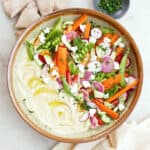
Hummus Platter with Vegetables
Learn how to make a beautiful hummus plate to serve as an easy appetizer for your next party! This recipe includes how to make homemade hummus, but you can substitute store-bought if desired.
Servings 8 as an appetizer
Calories 267kcal
Equipment
- Food processor (or high-powered blender, if making homemade hummus)
- Serving platter
Ingredients
Homemade hummus (can sub store-bought)
- 15 ounces chickpeas drained and rinsed, or 1.5 cups cooked chickpeas
- ½ teaspoon baking soda
- ⅓ to ½ cup tahini
- 1 medium clove garlic
- 2 to 4 tablespoons lemon juice from ½ to 1 medium lemon
- 3 tablespoons extra virgin olive oil
- 3 tablespoons ice water more as needed
- 1 teaspoon cumin
- ½ teaspoon salt
Toppings
- 3 small radishes thinly sliced
- 2 small watermelon radishes thinly sliced
- ½ large cucumber peeled and cut into pieces of desired size
- 2 large carrots peeled and cut into pieces of desired size
- 1 cup cherry tomatoes cut into quarters
- 1 cup sugar snap peas
- 2 tablespoons chopped fresh parsley
- 2 tablespoons chopped fresh mint
- 3 tablespoons crumbled goat cheese or feta
- Extra virgin olive oil for drizzling
- 4 whole wheat pita warmed and sliced into triangles
Instructions
- If you want to make homemade hummus, add the drained chickpeas to a saucepan with the baking soda and enough water to cover them by about 2 inches. Bring to a boil, reduce heat to maintain a boil but prevent overflow (if needed), and boil for 20 minutes. Drain and rinse. The chickpeas should be very soft and easily mushed between your fingers.
- In a food processor fitted with the S-blade or a high-powered blender, combine the tahini, lemon juice, garlic clove, and olive oil. Use a full ½ cup of tahini if you really like that flavor and ⅓ cup if you don't want as much. Blend until the garlic is pulverized and the ingredients are well-combined, about 1 to 2 minutes.
- While the food processor is running, pour the ice water through the hole in the top. It will make the consistency of the hummus a little fluffier.
- Stop the food processor, scraping down the sides as needed. Then add the chickpeas, cumin, and salt. Blend again for 1 to 2 minutes until the hummus is extremely smooth. Add more ice water, 1 tablespoon at a time, to thin and make it fluffier and creamier if needed. Taste and adjust seasonings, adding more lemon juice and salt if desired.
- Spoon the hummus onto a serving platter, spreading it with the back of your spoon.
- Arrange your hummus platter by nestling and sprinkling the vegetables on the hummus. Sprinkle the herbs and feta cheese on top, then drizzle everything with olive oil. Finally, put the pita rounds in a bowl outside the platter. I like to put the veggies right on top of the hummus on the platter and leave a little less than half of the hummus without toppings. That way, if people just want plain hummus to eat with pita, they can still access it.
- Serve, and enjoy! If you need to prep it ahead of time, wrap tightly with plastic wrap and keep in the fridge for up to 8 to 12 hours before serving.
- Leave a rating or review by tapping the stars on this recipe card (above) or in the comments section (at the end of the post)!
Notes
- For different variations, consider using roasted vegetables instead of raw.
- Blanched green beans and asparagus for spring
- Roasted tomatoes, peppers, zucchini, and red onion for summer
- Potatoes, beets, carrots, fennel, and parsnips for fall and winter
Nutrition
Calories: 267kcal | Carbohydrates: 31g | Protein: 9g | Fat: 13g | Saturated Fat: 2g | Polyunsaturated Fat: 4g | Monounsaturated Fat: 6g | Cholesterol: 2mg | Sodium: 535mg | Potassium: 436mg | Fiber: 6g | Sugar: 4g | Vitamin A: 2998IU | Vitamin C: 23mg | Calcium: 78mg | Iron: 3mg